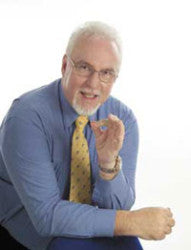Can you change the future? Part II - Painless Presentations
 It may seem a strange statement - 'changing the future' by giving a presentation or speaking at a conference, but bear with me. My claim is based on the testimony of people who have made statements like 'that presentation changed my career' and 'that talk took me to a higher level'.
It may seem a strange statement - 'changing the future' by giving a presentation or speaking at a conference, but bear with me. My claim is based on the testimony of people who have made statements like 'that presentation changed my career' and 'that talk took me to a higher level'.
Use your fears to inform your approach
I am not talking here about professional speakers - I am referring to audience member responses to regular turfcare professionals, groundsmen and greenkeepers who have had the courage to get up and speak up and, in doing so, have gone on to inspire their colleagues. So, yes - I assert that you are changing the future - one audience member at a time.
A good place for you to start, when contemplating public speaking, might be the fear and trepidation that can grip us at the very thought of standing up to give a talk. In fact, it might be interesting to use your fears to inform your approach to giving presentations in the workplace.
I have been training conference speakers for many years, and not one has ever claimed that they got to their feet to speak without some anxiety. Some, including me, start getting nervous often days or weeks in advance!
But, like so many other things, the more you do it the less you will suffer. Your fears and anxieties may also go through an interesting transition as you gather experience.
Most speakers start out worrying about themselves (Will I dry up? Do I look OK?). They then transition or progress to worrying about their material (Is my content OK? Are my visual aids going to work?). And, finally, they progress to worrying about their audience (Will I give them what they need?).
Prepare Yourself
This progression - Self/Material/Audience - is not an illogical one, and it can help you to prepare yourself and your talks … if you tackle them in reverse order. First find out who will be in the audience and what their expectations of you are. Once this is known, you can gather the data you need to construct your presentation and then, finally, you can make sure you look good and feel okay on the day.
Most people in your audience will want, most of all, to avoid presentations where the speaker gets embarrassed and messes up. They will have some concern and sympathy for the speaker but, more than anything, they want to avoid the embarrassment of witnessing and dealing with it.
It is, therefore, vital to spare your audience any anxiety. You can do this by preparing well and avoiding unnecessary risks. For example, you might have a great joke you want to tell. You figure that a good joke can be a great start to a talk. It is, however, a high return but a high risk option. If you absolutely have to make a joke, then make one against yourself so that your audience thinks you are mature enough to laugh at yourself sometimes.
A Simple Structure
Use a simple structure to put across a simple message and confine yourself to just three points. End with a 'call to action' and keep the whole thing to twenty minutes or less.
People will feel confident in you as a presenter if you use a simple structure, and they will appreciate this even more if you make reference to it - for example. 'I would like to begin by saying ...'; I would like to move onto my first point now ...' and 'In conclusion, let me summarise ...'
This technique (known as signposting) is the most under-used one in presentations and, yet, it makes the speaker sound logical and professional. I recommend it.
Introduction
Your introduction should indicate your content, your objective and when in the talk you intend to deal with questions from the audience. It helps if you can begin with something topical and relevant to get people's interest at the outset.
Main Part
As mentioned above, your presentation should not have more than three points. You might have just one message, but you should seek to establish and reinforce your message with no more than three points or examples. There is research that suggests that quoting three examples is very persuasive. Any less than three seems unconvincing, and any more could well be unnecessary.
Questions
In my experience, the best place for questions is just before your conclusion, e.g. 'Before I conclude are there any questions?' This prevents any over-enthusiastic questioners from hi-jacking your presentation at the end with irrelevant questions and distracting comments. Let them get it off their chest and then you can summarise and conclude your talk. This way you will stand a much better chance of restoring the audience's focus on your message.
Conclusion
Having dealt with questions, you can now make your concluding remarks and summarise your main points for emphasis.
The conclusion ought not to contain any new material or surprises. A simple and polite 'call to action' can also be very effective at the end, e.g. 'I hope that we will now be able now to make an informed decision on this matter. Thank you for your time'.
Frank Newberry has been helping people in the turfcare sector to get better results for over twenty years. If you are new to public speaking, or if you are an old hand looking to take your performance to the next level with a Speaker Masterclass, you can contact Frank by email or by telephone via the contact tab of his personal website which is www.franknewberry.com.
